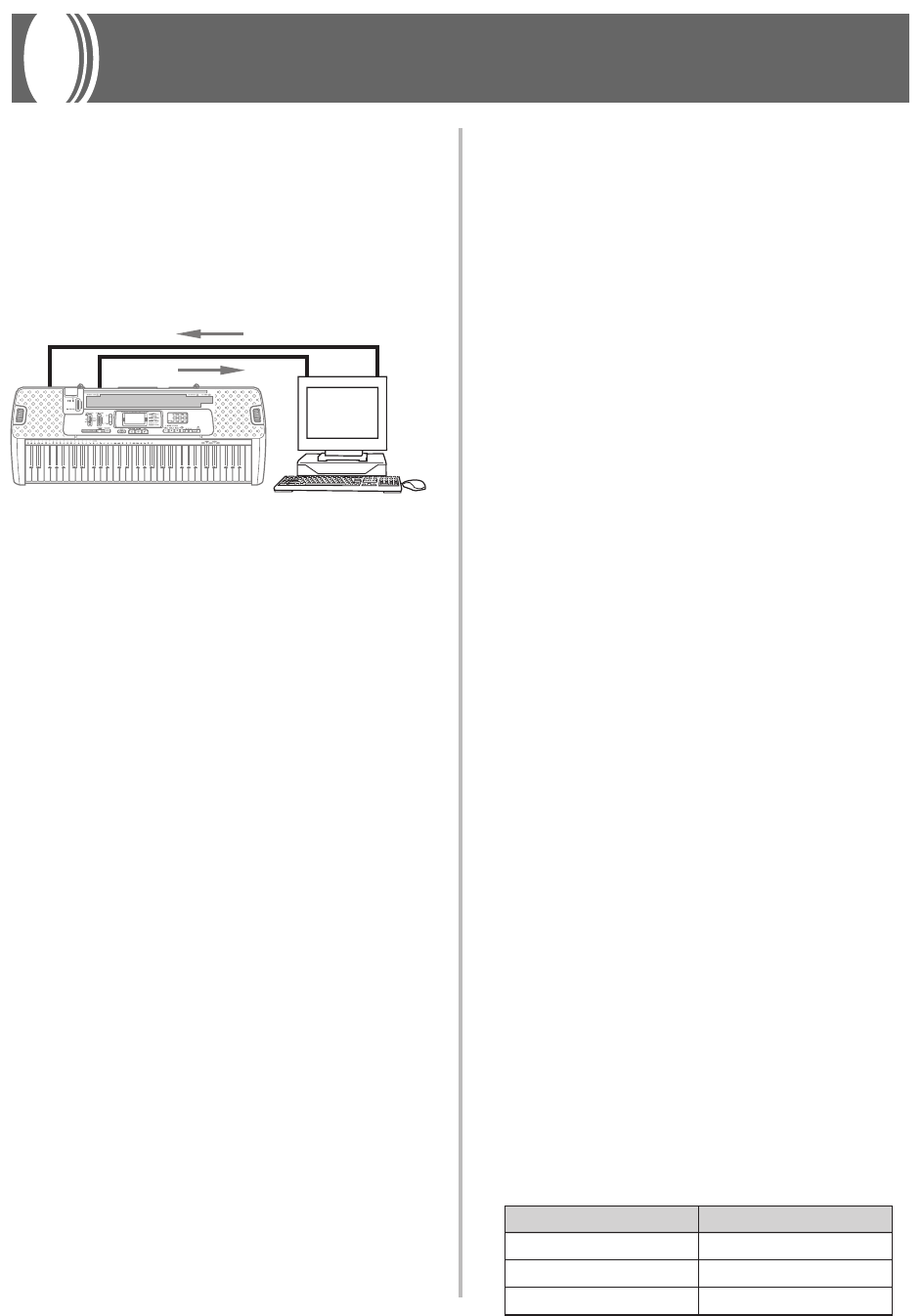
E-27
MIDI
What is MIDI?
The letters MIDI stand for Musical Instrument Digital
Interface, which is the name of a worldwide standard for
digital signals and connectors that makes it possible to
exchange musical data between musical instruments and
computers (machines) produced by different manufacturers.
MIDI Connections
General MIDI
General MIDI standardizes MIDI data for all sound source
types, regardless of manufacturer. General MIDI specifies
such factors as tone numbering, drum sounds, and available
MIDI channels for all sound sources. This standard makes it
possible for all MIDI equipment to reproduce the same
nuances when playing General MIDI data, regardless of the
manufacturer of the sound source.
Though the sound source of this keyboard is not General
MIDI compatible, you can still connect the keyboard to a
computer or other MIDI equipment to playback General MIDI
data that is widely available in stores, over computer
networks, and from other sources.
❚
NOTE
• General MIDI data made up of a large number of parts may not
play correctly on this keyboard.
• You will have most success playing back General MIDI data
that has few parts and is made up of parts on channels 1, 2, 3,
4, and 10.
Messages
There is a wide variety of messages defined under the MIDI
standard, and this section details the particular messages that
can be sent and received by this keyboard.
NOTE ON/OFF
This message sends data when a key is pressed (NOTE ON)
or released (NOTE OFF).
A NOTE ON/OFF message includes a note number (to
indicate note whose key is being pressed or released) and
velocity (velocity=100 when the volume value of this unit is
9 to 2, and velocity=75 when the volume value is 1 or 0).
NOTE ON velocity is always used to determine the relative
volume of the note. This keyboard does not receive NOTE
OFF velocity data.
Whenever you press or release a key on this keyboard, the
corresponding NOTE ON or NOTE OFF message is sent by
constant velocity from the MIDI OUT terminal.
PROGRAM CHANGE
This is the tone selection message. PROGRAM CHANGE can
contain tone data within the range of 0 to 127.
A PROGRAM CHANGE message (0 to 99) is sent out through
this keyboard’s MIDI OUT terminal whenever you manually
change its tone number. Receipt of a PROGRAM CHANGE
message from an external machine changes the tone setting
of this keyboard.
This keyboard can send tone data within the range of 00 to
99 and receive tone data within the range of 0 to 127*. Each
of the 128 General MIDI tones is automatically assigned to
one of the keyboard’s 100 built-in tones as shown on page A-
1. Select this setting when you want to listen to General MIDI
data from a computer or other external equipment.
* When GM mapping is turned on (page E-28). When turned
off, tone data is received in the range of 0 to 99.
❚
NOTE
• Channel 10 is for the drum part only, and it does not receive
Program Change messages. When receiving MIDI data, it
sounds percussion sounds produced by this keyboard.
PITCH BEND
This message carries pitch bend information for smoothly
sliding the pitch upwards or downwards during keyboard
play. This keyboard does not send pitch bend data, but it can
receive such data.
CONTROL CHANGE
This message adds effects such as vibrato and volume changes
applied during keyboard play. CONTROL CHANGE data
includes a control number (to identify the effect type) and a
control value (to specify the on/off status and depth of the
effect).
The following is a list of data that can be received using
CONTROL CHANGE.
662A-E-029A
MIDI IN MIDI OUT
MIDI IN MIDI OUT
Computer etc.
Effect Control Number
VOLUME 7
HOLD1 64
MODULATION 1


















